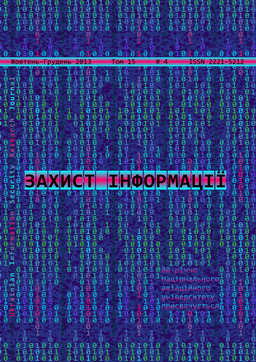Information encryption algorithm based on two chaotic dynamic systems for secure communication systems
DOI:
https://doi.org/10.18372/2410-7840.15.5713Keywords:
cryptography, encryption, decryption, dynamical systems, chaos, algorithm, evaluation of securityAbstract
At the present stage of development of information technology, telecommunication equipment and computer equipment commonly raises the problem of protecting confidential information against unauthorized access when it is transmitting or storing. To solve this problem often turn to cryptographic methods of information security. In addition to encryption methods based on algebraic concepts, conducted the development of algorithms based on deterministic chaos. In this paper presents an algorithm encrypt text data, based on the use of two dynamical systems, systems Roessler and cubic map. Ressler system used for generation of the initial conditions used cubic map when encrypting each character of message. As a result of this algorithm plaintext symbols incoming messages by encrypting replaced by integers. The work was also carried out modeling of dynamic systems in Matlab environment and given an example an example of the application written in Delphi 7. In this paper also assessed the security of the proposed algorithm. The algorithm has a large number of encryption keys, that making the process of their selection is very difficult. Using two dynamic systems complicates the possibility of statistical attacks.References
Шахтарин Б.И., Кобылкина П.И., Сидоркина Ю.А., Кондратьэв А.В., Митин С.В. Генераторы хаотических колебаний. Галилеос АРВ. — Москва. - 2007 - C. 247
Кузнецов А.П., Савин А.В., Тюрюкина Л.В.Введение в физику нелинейных от ображений // Сара¬тов: изд-во «Научная книга». — 2010. — C. 134.
Pecora L.M. and Carroll T.L. Synchronization in Chaotic Systems / / Phys. Rev Lett. - Vol. 64. — 1990. — P. 821.
Lawande Q.V., Ivan B. R. and Dhodapkar S. D. Chaos based cryptography: a new approach to secure comunication // BARC. — NEWSLETTER. — No. 258. — July 2005. — P. 1
Baptista M. S. Cryptography with chaos// Phys. Lett.— A 240. — 1998. — P. 50.
Arvind T., Chandana S. Nilavan and Prof. Prithviraj V. New approach to information security through nonlinear dynamics and chaos // National Workshop on Cryptology. - Oct. 16-18. — 2003. — Chennai.
May R.M. Simple mathematical model with very complicated dynamics / / Nature 261. — 1976. — P. 459.
Shahtarin B.I., Kobylkina P.I., Sidorkina Ju.A., Kon- drat'jev A.V., Mitin S.V. Generatory haoticheskih kole- banij. Galileos ARV, Moskva, 2007, P. 247.
Kuznecov A.P., Savin A.V., Tjurjukina L.V.Vvedenie v fiziku nelinejnyh ot obrazhenij, Saratov: izd-vo «Nauchnaja kniga». 2010, P. 134.
Pecora L.M. and Carroll T.L. (1990) Synchronization in Chaotic Systems, Phys. Rev Lett., Vol. 64, P. 821.
Lawande Q.V., Ivan B.R. and Dhodapkar S.D. (2005) Chaos based cryptography: a new approach to secure communication, BARC, Newsletter, No. 258, P. 1.
Baptista M. S. (1998) Cryptography with chaos, Phys. Lett., A 240, P. 50.
Arvind T., Chandana S. Nilavan and Prof. Prithviraj V. (2003) New approach to information security through nonlinear dynamics and chaos, National Workshop on Cryptology, Chennai.
May R.M. (1976) Simple mathematical model with very complicated dynamics, Nature 261, P. 459.
Downloads
Issue
Section
License
Authors who publish with this journal agree to the following terms:- Authors retain copyright and grant the journal right of first publication with the work simultaneously licensed under a Creative Commons Attribution License that allows others to share the work with an acknowledgement of the work's authorship and initial publication in this journal.
- Authors are able to enter into separate, additional contractual arrangements for the non-exclusive distribution of the journal's published version of the work (e.g., post it to an institutional repository or publish it in a book), with an acknowledgement of its initial publication in this journal.
- Authors are permitted and encouraged to post their work online (e.g., in institutional repositories or on their website) prior to and during the submission process, as it can lead to productive exchanges, as well as earlier and greater citation of published work (See The Effect of Open Access).

